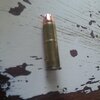Col. Harrumph
Member
Reloading some .357 mags for the Ruger, which has been feeling kinda left out lately. So: 16.9 gr H110, Federal SPM's, Hornady 158 gr HTPs, brass is headstamped CBC which Google says is made in Brazil (and seems OK, Magtech sources from them). Anyway, I scrunched this one today, as shown:

This wasn't too bad; it still chambers. But what gives? The die hasn't moved and is still in adjustment. The only thing I can think of: The case stretched to the point it hit the crimp step before the bullet was fully seated. I've never bothered to check case length with straight wall handgun brass; I guess I'll have to change that. (Sorry for the soft focus.)
BTW, just because I load 16.9 grains of H110 doesn't mean you should. Take it easy!

This wasn't too bad; it still chambers. But what gives? The die hasn't moved and is still in adjustment. The only thing I can think of: The case stretched to the point it hit the crimp step before the bullet was fully seated. I've never bothered to check case length with straight wall handgun brass; I guess I'll have to change that. (Sorry for the soft focus.)
BTW, just because I load 16.9 grains of H110 doesn't mean you should. Take it easy!

